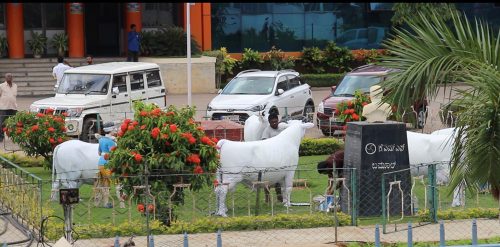In the morning slot on the second day of the ART Marathon, in the middle of the gallery on a green drop cloth, stood a 30-year-old bicycle. When the bell rang announcing the start of the show, the artist Suresh Kumar G entered, in the sartorial garb of a mechanic—open half sleeved shirt over a full sleeves shirt—with tools in hand: wrench, screwdriver, hammer and pliers. Suresh’s performance for the next 45 minutes consisted of dismantling the old bicycle, which he inherited from his father, while narrating the story of the cycle. On the surface it appears as a mundane and inconsequential act, but at a deeper level it connects differentiated temporalities—artists own past and the current events surrounding Venkatappa Art Gallery—conceptually and in actuality.
A three-day ART Marathon from May 9 to 11, 2016 was organized by the Venkatappa Art Gallery Forum, a platform of artists protesting the Karnataka State Government’s decision to handover the only public art gallery in the state to a private collector. The ART Marathon began at 11 in the mornings and ended at 7 in the evenings. Each day was divided into 9 slots; each slot showcased 4 to 5 artists, including a live performance or action; and a video or sound artist. In total, during the three days of ART Marathon, over 120 artists showed their works in the gallery. These collectively curated art displays and performances, that would change every 45 minutes, generated energy, vibrancy and dynamism previously unseen in an art event. More subtle and creative than AgitProp, the ART Marathon was not only a novel display technique, but was also about artists coming together as agitators for collective action, deploying instruments of practice at their disposal: space and art.
The performance of dismantling the bicycle became a site of overlapping temporalities and histories. The bicycle that was disassembled during Suresh’s performance is the core through and around which his memories about his father, childhood and student days are woven together. His father, as an employee of the Aeronautical Development Establishment (ADE) in Bangalore, used to travel to work and back home on this bicycle. As a child Suresh memorised the parts of the bicycle from an English manual that came with it. He washed it and cleaned it everyday. As a student of sculpture at Chitra Kala Parishad (CKP), a publicly funded art school in Bangalore, and later in Ahmedabad as an artist-in-residence, Suresh used the same bicycle to transport discarded pieces of wood picked up from construction sites to be carved into works of art, deeply embedded in his personal experiences. The bicycle symbolism extends beyond the biographical. Culturally, as narrated by well-known Kannada writer Kuvempu in his novel Malegalali Madumagalu (1967), the bicycle was an object of wonder and a harbinger of modernity, of self-mobility and speed when it was brought first by the British to the Western Ghats. As the narrator observes in the novel, the bicycle had greater impact on people than the figure of Christ. (Pithamber R. Polsani, 2016)


